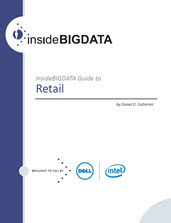Today SGI announced that enterprises can now leverage the Intel-based SGI UV 300H server in a multi-node cluster (scale out) to run SAP Business Warehouse (SAP BW) on SAP HANA or new SAP BW/4HANA. Unique to SGI, the cluster nodes can later be reconfigured as single-node systems with 1 to 32TB of shared memory (scale up) to run SAP S/4HANA and other real-time applications. “For large enterprises that plan to migrate to SAP S/4HANA but wish to begin their journey to SAP HANA with SAP BW, our new SGI cluster offering is unquestionably the optimal solution,” said Jorge Titinger, president and CEO, SGI. “The scalability of the SGI UV 300H architecture coupled with our expertise in mission-critical environments provides an ideal path to real-time business with SAP HANA.”
insideAI News Guide to Healthcare & Life Sciences
This technology guide provides an overview of the utilization of big data technologies as an emerging discipline in healthcare and life sciences. It explores the characteristics of this business strategy and the benefits of leveraging big data technologies within these sectors. It also touches on the challenges and future directions of big data and analytics in the healthcare and life sciences industries. To learn more download this insideAI News guide.
Intel Xeon Phi Processor Code Modernization Nets Over 55x Faster NeuralTalk2 Image Tagging
“Benchmarks, customer experiences, and the technical literature have shown that code modernization can greatly increase application performance on both Intel Xeon and Intel Xeon Phi processors. Colfax Research recently published a study showing that image tagging performance using the open source NeuralTalk2 software can be improved 28x on Intel Xeon processors and by over 55x on the latest Intel Xeon Phi processors.”
Leveraging big data to gain a competitive advantage across a range of industries
In their efforts to extract value from big data, organizations around the world are turning to the Hadoop big data collection, management and analysis platform. Hadoop offers two important services: store any kind of data from any source, inexpensively and at very large scale, and perform sophisticated analysis of that data easily and quickly. To learn more about Hadoop and big data download this white paper.
Intel Cloud Edition for Lustre Software
With Intel Cloud Edition for Lustre software, users can easily add, remove, or reconfigure AWS resources to match their workloads and budgets for optimal return on investment. In addition, new applications are being designed and deployed exclusively onto the AWS infrastructure for unmatched total cost of ownership (TCO).
insideAI News Guide to Retail
Few industries have greater access to data around consumers, products, and channels than the retail industry. Data coupled with insights are at the heart of what drives this business. It’s a logical consequence then that retail is the vertical market that adopted big data and technologies like Hadoop earlier than many other industries. Retail started with diverse transactional data but is now much more sophisticated in the way technology is being applied toward gaining competitive advantage. Learn more by downloading this guide.
insideAI News Guide to Scientific Research
This technology guide is geared toward scientific researchers working at universities and other research institutions (e.g. NASA, JPL, NIH, etc.) who may benefit from learning more about how big data is meaningfully transformative in the way it can be applied to the data collection and analysis part of their projects. Further, we’ll illustrate how Dell big data technology solutions powered by Intel are actively helping scientists who are focused on their data, on their models and on their research results. Learn more by downloading this guide.
insideAI News Guide to Big Data for Manufacturing
Manufacturing concerns consistently have sought ways to reduce waste and variability in their production processes to dramatically improve product quality and yield (e.g. the amount of output per unit of input). Further, these companies need a granular approach toward recognizing and correcting manufacturing process flaws. Big data technology provides just such an approach and many hightier manufacturers possess a significant degree of interest and motivation in adopting the big data technology stack.
insideAI News Guide to Big Data for Finance
Introduction to Big Data for Finance According to the 2014 IDG Enterprise Big Data research report, companies are intensifying their efforts to derive value through big data initiatives with nearly half (49%) of respondents already implementing big data projects or in the process of doing so in the future. Further, organizations are seeing exponential growth in the amount of data managed with an expected […]
insideAI News Guide to Big Data Business Solutions in the Cloud
In this Guide, we take a look at what Lustre on infrastructure AWS delivers for a broad community of business and commercial organizations
struggling with the challenge of big data and demanding storage growth. Learn more by downloading this Guide.













